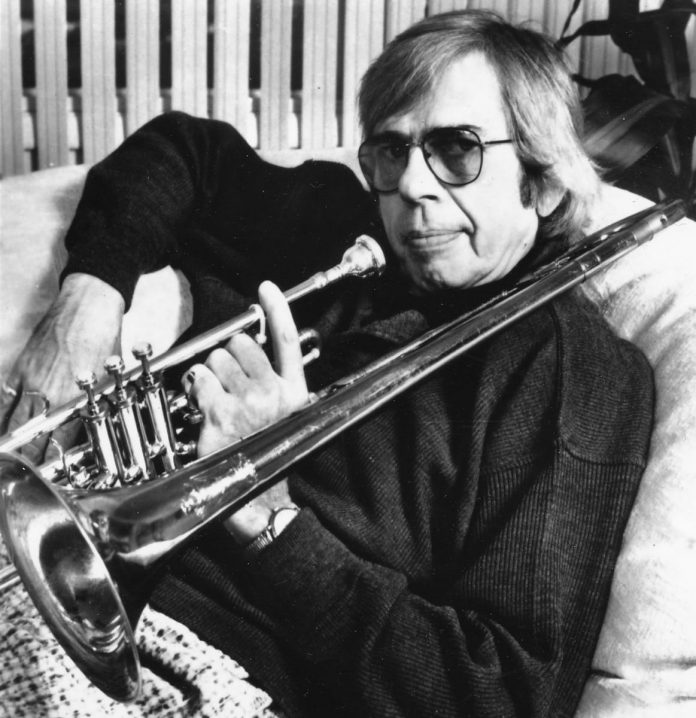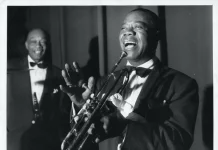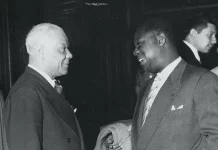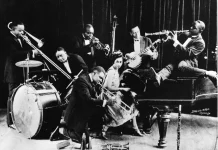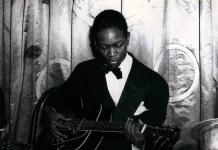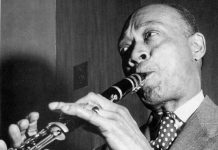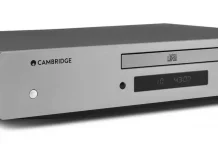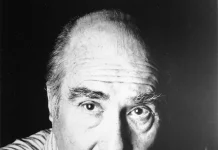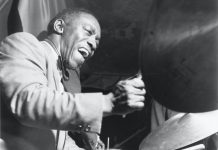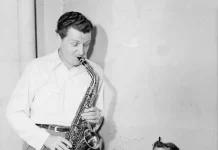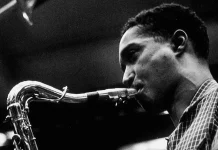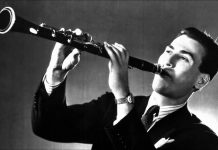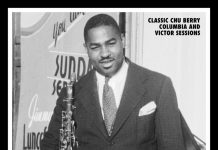One of the main changes in Bob’s playing came in the first half of the 60s and it’s represented by three albums that I regard as a hinge. Usefully, two of them are combined into one CD, available today, on Phoenix 131613. They’re by two quartets and are The Blues Hot And Cold and 7 X Wilder.
There was a lot of hot and not much cold about the former, which is a detailed catalogue of all the effects and devices of what I regard as the Brookmeyer style at its best.
Here Bob takes advantage of the trumpet fingering of his instrument to use squeezed and half-valve notes in a magnificent half dozen numbers. Four of them are standards. The magnificent Languid Blues (which more than any other track has a complete compendium of the Brookmeyer style of the day) and the title track run for more than seven minutes each, with every curl of blues playing that you could wish for. Stoppin’ At The Savoy gains its name from the unprecedented and imaginative breaks that Bob has inserted and the whole album is a lesson in how to improvise mainstream jazz. The superb pianist Jimmy Rowles has been underrated both in life and posthumously. Buddy Clark’s bass solos are prodigious, and Mel Lewis and Bob had by this time worked up a great understanding and lifelong friendship.
Bob had also formed a great friendship with Alec Wilder, one of the finest of American composers. You can tell that the record company and not Bob titled the album, for there are only six of Alec’s tunes, with a blues by Bob added. Mel Lewis is there again for these sensitive interpretations, and two other long-time Brookmeyer associates, guitarist Jim Hall and bassist Bill Crow, round out the group. As with the blues album, no discipline is inflicted on the players and the spacious relaxation produces wonderful music.
After a series of gruff and flying improvisations at the beginning of It’s So Peaceful In The Country, Bob plays, for his second solo, one of the most athletic series of runs that the instrument could stand, starting at the top and cascading down and up through the registers with casual aplomb – two words that usefully describe the whole wonderful session. That solo is surely one of Bob’s most spectacular ever. Given the wonderful material this album couldn’t fail. (Bob plays piano on some of these tracks, including his own Blues For Alec, and he also made a superb and intriguing album of piano duets with Bill Evans – The Ivory Hunters on Blue Note CDP 7243 8 27324 26 – but Bob’s work on his first instrument and also the major talent of his arranging ability must be considered on another day).
The third album from my hinge is one that I’ve written about before in this magazine. It’s from November 1961 and is on Verve 314 527 658. It is called Gloomy Sunday And Other Bright Moments and it’s coupled with an album made a week earlier by the same band but this time under Gary McFarland’s name. The ridiculously strong team of soloists includes Clark Terry, Joe Newman, Phil Woods, Al Cohn, Hank Jones, Kenny Burrell and even the drummer who hated taking solos, Mel Lewis. The wonderful arrangers are, apart from Bob, Ralph Burns, Eddie Sauter, Al Cohn and Gary McFarland.
I have 40 or so albums under Bob’s leadership in my collection, but there’s room here to draw your attention to only two of them. The first one still has links to the earlier work, filled with subtle but easily interpreted improvisations by Bob and the fine pianist Ted Rosenthal. Done in August 2001, it’s called One Night In Vermont (Planet Arts 200123) and is made up of seven high-quality standards.
Here are some reflections from Bob:
‘Seeing Basie produced my first “body thrill” and I decided I had to do something like that to survive a very grey childhood’
“I was born in Kansas City, Missouri on 19 December, 1929. My father liked music and bought me an old clarinet when I was eight. It became a trombone at 13 (against my wishes, preferring drums or trumpet), but that also led to an infatuation with blank music paper. So, at 14 I became a professional arranger/copyist, writing for local dance bands. In 1941 I heard the original Basie band at the Tower Theatre in Kansas City with Lester, Jo Jones, all the greats. Seeing Basie produced my first ‘body thrill’ and I decided I had to do something like that to survive a very grey childhood. So I went to KC Conservatory for three years and came out to play with Orrin Tucker then three months in Chicago playing with Tiny Kahn, Lou Levy, Frank Rosolino etc.
“After a short stint in the army (a six-month mistake on both our parts) I joined Tex Beneke, courtesy of Mel Lewis. I left Tex to work with folks who could help me get my union card – Ray McKinley and Louis Prima – and worked as a house musician at Stuyvesant Casino, playing with Buck Clayton, Ben Webster, Coleman Hawkins and on one memorable night with George Wallington, Pops Foster and Zutty Singleton – a rhythm section to remember. Claude Thornhill reformed in the fall of ’52, so I became a full-time valve trombonist, selling my slide to the other guy, and remained as second pianist. That period included my first performance with Charlie Parker – a rehearsal with Bird and strings, and my first ever performance at Birdland, playing piano with my hero, Bill Harris.
“Looking back over my first years in New York, they included some memorable moments – a concert at Town Hall with Coltrane, Pepper Adams, Basie, George Duvivier and Art Taylor – you cannot imagine in your wildest dreams what it felt like with Basie in a small band. It was the energy peak of all time.
“In January 1960 Gerry dropped by one day and the Concert Jazz Band was born – a dream come true for me to have a band that I could influence, write for and be proud of. We lasted until December 1964, closing the original Birdland in grand style – scotch, cocaine and Santa Claus!”
The Concert Jazz Band of the 60s was indeed one of the best creations of the decade. Bob used to rehearse the band, wrote a substantial part of the library and generally saw to things when Gerry wasn’t around. I suggested to him once that it was his band more than it was Gerry’s, but he wouldn’t hear of the idea.
“Things just kept happening – the two piano album with Bill Evans in 1959, the midnight call from Duke Ellington asking me to join the band, Sonny Rollins asking me to record, and four nights jamming with Monk in Paris, starting a long friendship.”
In the 60s Bob was a founding member of the Thad Jones-Mel Lewis Orchestra, writing an eminent part of the band’s library. Over the next two decades he worked in a variety of settings, including studio work and directing the Thad Jones-Mel Lewis band. He continued to write and compose and spent most of his time in Europe where he taught, established his New Quartet and worked in front of a variety of big bands.
Artistically triumphant, Bob’s career in Europe was financially rickety and his financing of a CD by his New Art Orchestra (Challenge Records CHR 70066) cost him between 20 and 30 thousand dollars.
“Now, as I teach around the world”, he told Challenge in the early 90s, “part of my message is delivered when the younger person looks at me, nearly 70 and just beginning – still learning, playing my best, still trying to write the ‘perfect’ piece and telling them that the job is long, the effort monumental and if they don’t have to have it, someone else does. I help them understand the basic musical speech in the simplest fashion with no clichéd responses accepted. It is sometimes a huge task, but it is possible and must be done.”
‘There is a coloured way of playing in the same way that there is a particularly Jewish style of playing. The Jewish style results from a similar sort of oppression’
Oh, I forgot to tell you about that predicament I mentioned at the beginning of all this. In my Melody Maker interview with Bob I reported him saying “There is a coloured way of playing in the same way that there is a particularly Jewish style of playing. The Jewish style results from a similar sort of oppression.
“Listen to Al Cohn, for instance, one of the most highly respected musicians in New York. He’s a completely natural musician who plays great music in the Jewish idiom. Most of the East Coast jazz school shows strong Jewish influences in the same way that earlier forms of jazz showed strong Southern influences.”
When next we met, Bob told me that this paragraph caused him great embarrassment amongst his Jewish friends and particularly in regard to Al Cohn, ever one of Bob’s closest friends. I wrote down what Bob told me on that occasion and of course didn’t make anything up. But Bob is not here to elucidate further, so the matter must rest unresolved.
It seems like leaving a job unfinished, but I must leave the accounting of the last years of Bob’s life and his European career in the necessary detail to someone else.

